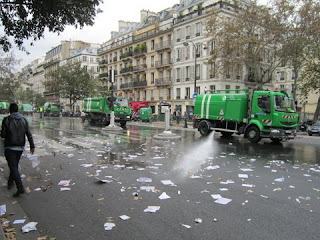skip to main |
skip to sidebar
Sue Chenette: Manif
We found out about last Tuesday’s manif—short for manifestation, the French word meaning demonstration—halfway home from our morning class at Alliance Française.
The bus driver was ordered to turn around and head back to the station because of congestion in the streets ahead. This happens often in Paris. Time to walk, or find the nearest métro.
The French don’t balk at expressing indignation. In my Alliance Française text, one lesson is devoted to appropriate expressions (C’est scandaleux! Mais il est fou!) along with the grammatically proper use of the past conditional tense pour protester.
On Tuesday the manifestants from unions and universities were out in full force with banners and balloons, protesting government austerity measures which would mean across-the-board job cuts. The march continued for the two hours that I lingered, with a book and a chocolat chaud, in the corner café where we emerged from the métro. It was festive: crowds and colour and chanting.
Both the marchers and the municipal crew, who follow with their hoses and brooms and leaf blowers for the pamphlets, know their parts well. There’s an established routine. You might almost call it a ritual. You could make the case that the French take to the streets to celebrate the idea of their solidarity, and that the demonstrations accomplish little beyond that. I asked the waiter who brought my check what the demonstration was about. “Je ne sais pas,” he said with a shrug.
On Saturday afternoon, les Indignés (the Indignants) filled the plaza in front of Hotel de Ville, joining in the global Indignant Citizens Movement. I wasn’t there, but I found a video online. I was struck by the absence of banners and balloons. It seemed different. More sober. And left me wondering, could this lead to change?


















No comments:
Post a Comment